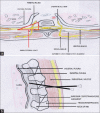Recent advances in cardiac anaesthesia
- PMID: 36970488
- PMCID: PMC10034928
- DOI: 10.4103/ija.ija_972_22
Recent advances in cardiac anaesthesia
Abstract
The speciality of cardiac anaesthesia has rapidly evolved over the past few decades with advances in technology, including artificial intelligence (AI), newer devices, techniques, imaging, pain relief and a better understanding of the pathophysiology of disease states. Incorporation of the same has led to improved patient outcomes in terms of morbidity and mortality benefits. With the advent of minimally invasive surgical methods, minimising the dose of opioids and ultrasound-guided regional anaesthesia for pain relief, enhanced recovery after cardiac surgery has been made possible. Perioperative imaging including 3D transoesophageal echocardiography, newer devices and drugs and AI algorithms will play a significant role in cardiac anaesthesia. This review briefly addresses some of the recent advances that the authors believe can impact the practice of cardiac anaesthesia.
Keywords: Anaesthesiology; artificial intelligence; recent advances.
Copyright: © 2023 Indian Journal of Anaesthesia.
Conflict of interest statement
There are no conflicts of interest.
Figures





References
-
- El Shora HA, El Beleehy AA, Abdelwahab AA, Ali GA, Omran TE, Hassan EA, et al. Bilateral paravertebral block versus thoracic epidural analgesia for pain control post-cardiac surgery:A randomized controlled trial. Thorac Cardiovasc Surg. 2020;68:410–6. - PubMed
-
- King M, Stambulic T, Hassan SMA, Norman PA, Derry K, Payne DM, et al. Median sternotomy pain after cardiac surgery:To block, or not?A systematic review and meta-analysis. J Card Surg. 2022;37:3729–42. - PubMed
-
- Devarajan J, Balasubramanian S, Nazarnia S, Lin C, Subramaniam K. Regional Analgesia for Cardiac Surgery Part 1. Current status of neuraxial and paravertebral blocks for adult cardiac surgery. Semin Cardiothorac Vasc Anesth. 2021;25:252–64. - PubMed
-
- Devarajan J, Balasubramanian S, Shariat AN, Bhatt HV. Regional Analgesia for Cardiac Surgery. Part 2:Peripheral Regional Analgesia for Cardiac Surgery. Semin Cardiothorac Vasc Anesth. 2021;25:265–79. - PubMed
LinkOut - more resources
Full Text Sources
Miscellaneous
